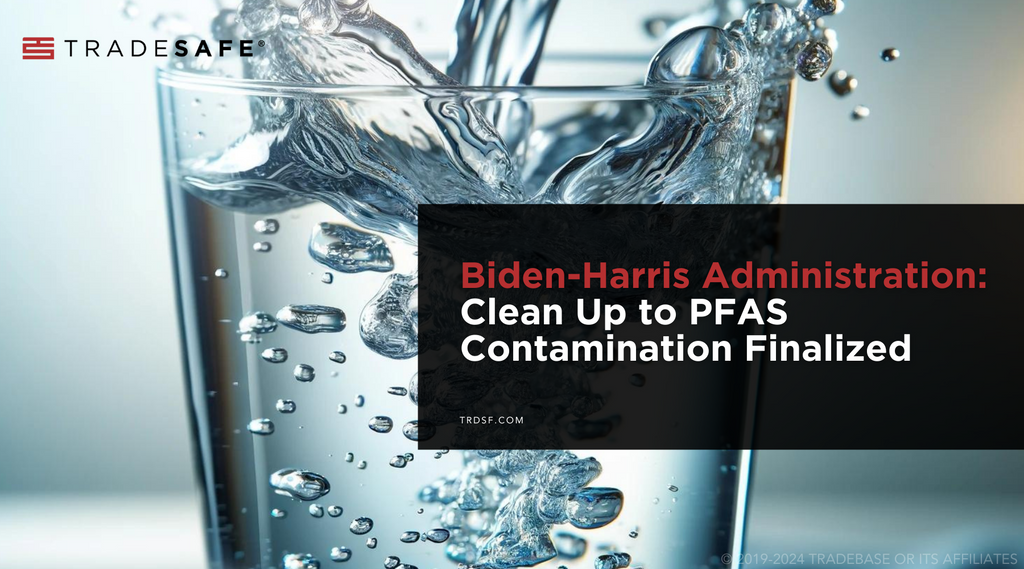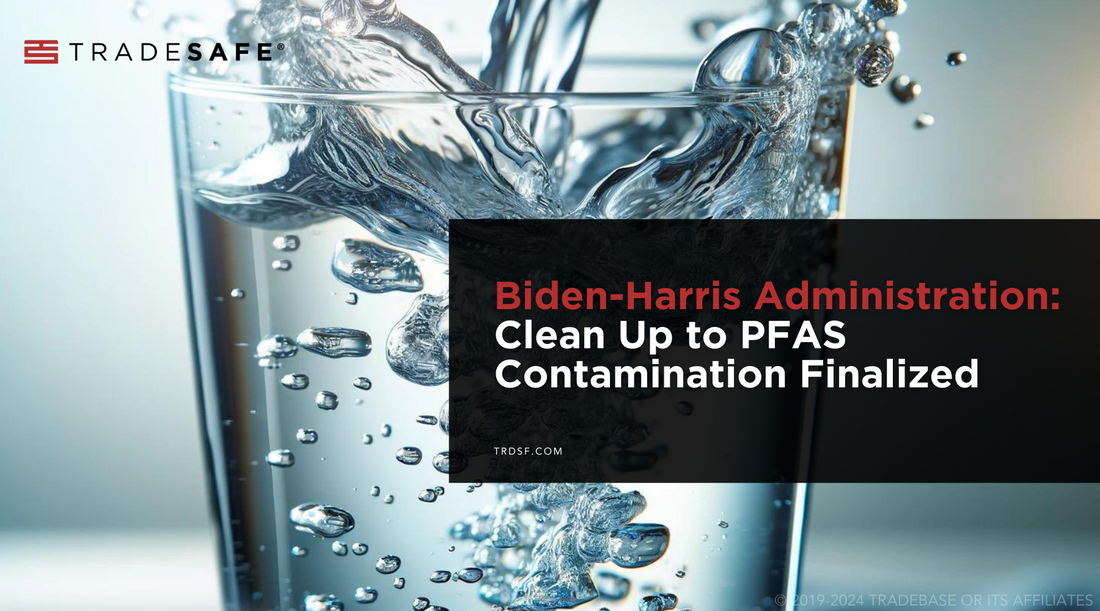
On April 19, 2024, the Biden-Harris Administration has taken significant steps to address the contamination from per and polyfluoroalkyl substances (PFAS), commonly known as "forever chemicals," through the Environmental Protection Agency (EPA). The Administration has finalized a critical rule to clean up PFAS contamination, which includes designating PFOA and PFOS as hazardous substances under the Comprehensive Environmental Response, Compensation, and Liability Act (CERCLA, commonly known as Superfund). This designation enables the EPA to hold polluters accountable for cleanup costs and to expedite remediation efforts at contaminated sites.
Additionally, the EPA has established the first-ever national drinking water standards for PFAS, setting legally enforceable levels for certain PFAS compounds. This rule is aimed at reducing exposure to these toxic chemicals in drinking water, thus preventing serious health issues, including certain cancers and developmental harms in children. “The first-ever Safe Drinking Water Act standards for some PFAS chemicals are a win for impacted communities, a welcome promise kept, and a wake-up call,” said Jeff Carter, President, Clean Water Action.
These actions are part of the EPA's PFAS Strategic Roadmap, which outlines a comprehensive approach to managing PFAS pollution. The Roadmap includes steps to control PFAS at its sources, ensure science-based decision-making, and address the impacts on disadvantaged communities. It reflects a whole-of-government effort to tackle the issue of PFAS pollution and protect national health.
Key Aspects of the PFAS Rule
| Aspect | Details |
| Hazardous Substance Designation | The EPA has designated PFOA and PFOS as hazardous substances under CERCLA (Superfund). This requires immediate reporting of releases exceeding a specified amount and ensures that cleanup costs are borne by the polluters, not taxpayers. |
| Enhanced Clean-up Measures | With PFAS classified as hazardous, the EPA can better manage and prioritize the cleanup of contaminated sites. This measure aims to prevent further environmental migration of these chemicals, protecting public health. |
| Legal and Financial Accountability | The rule enables the EPA to hold manufacturers and significant polluters accountable, ensuring they cover the costs of investigations and cleanups. |
| Community and Environmental Protection | New regulations require federal entities transferring or selling property to disclose any PFAS use, storage, or disposal on the property, and ensure any contamination is properly addressed. |
Understanding PFAS
Per- and polyfluoroalkyl substances (PFAS) are a group of synthetic chemicals that have been used extensively in various industries since the 1940s. Due to their unique ability to resist heat, water, and oil, PFAS compounds are commonly found in a wide range of consumer products now, including non-stick cookware, water-repellent fabrics, stain-resistant carpets, and some firefighting foams. These chemicals are highly durable and resistant to degradation in the environment and human body, hence dubbed "forever chemicals."
Where are PFAS Found?
PFAS chemicals are not only pervasive but also remarkably resilient due to their chemical structure. They are found in:
- PFAS in Drinking Water: PFAS are commonly detected in public water systems due to their extensive use and disposal. EPA has reported that PFAS compounds can be found in the drinking water of an estimated 16 million Americans, though more recent research suggests this number could be significantly higher.
- PFAS in Soil and Groundwater: Factories that manufacture or use PFAS contribute to soil and groundwater contamination through waste products. It can also accumulate near fire training areas and from the use of biosolids (treated sewage sludge) as fertilizer in agriculture, which can be rich in PFAS due to their presence in household waste.
- PFAS in Airborne Particles: PFAS can become airborne from factory emissions and from the volatilization of contaminated soils or products. This airborne transport can lead to deposition in areas far removed from original sources of contamination.
- PFAS in Food: Certain food wrappers, boxes, and containers are coated with PFAS to prevent oil and water from soaking through the packaging. Fish and livestock can also absorb these chemicals from contaminated water and feed, respectively.
PFAS Extent of Contamination and Population Impact
“A growing body of scientific research shows that PFAS chemicals are more harmful to human health than previously thought, and at extremely low levels,” said Dr. Anna Reade, Director of PFAS Advocacy, Natural Resources Defense Council. “Safe water is a human right and reducing exposure to even just six of the thousands of PFAS is a worthy start to tackling this massive public health and environmental crisis.”
A 2021 study by the Environmental Working Group (EWG) estimates that over 200 million Americans might be consuming drinking water contaminated with PFAS at levels that could pose health risks. Similarly, the Centers for Disease Control and Prevention (CDC) has detected at least 12 PFAS compounds in the blood of 97% of Americans, underscoring the widespread nature of this exposure.
Furthermore, analyses of groundwater sources demonstrate that PFAS contamination extends beyond industrial areas, affecting many rural and suburban communities nationwide. This pervasive contamination highlights the urgent need for comprehensive measures to address the presence of these harmful chemicals in the environment.
PFAS Health Effects
The threat of PFAS contamination on health is profound and far-reaching. More research has increasingly linked PFAS to a host of adverse health outcomes, including:
- Increased risk of certain cancers: Studies have shown correlations between PFAS exposure and heightened risks of kidney and testicular cancers.
- Thyroid problems: PFAS can disrupt thyroid function, potentially leading to hypothyroidism or other metabolic issues.
- Immune system disruption: There is evidence that PFAS exposure can weaken immune system responses, particularly concerning children.
- Developmental problems in children: PFAS exposure during pregnancy and childhood has been linked to developmental delays and decreased birth weight.
EPA’s Advanced PFAS Mitigation Efforts
Since launching the PFAS Strategic Roadmap in 2021, EPA has implemented several critical measures to address the challenges posed by per- and poly-fluoroalkyl substances (PFAS), including:
- Establishment of Drinking Water Standards: The EPA established the National Primary Drinking Water Regulation (NPDWR), the first-ever national legally enforceable drinking water standard for PFAS in April 2024. This significant move set maximum contaminant levels (MCLs) for six PFAS compounds, compelling public water systems across the country to meet these standards through improved treatment and monitoring practices.
- Financial Initiatives: EPA dedicated approximately $9 billion in funding to help address PFAS and other emerging contaminants in drinking water. This funding is part of the larger infrastructure investments aimed at enhancing the capability of water utilities to meet new standards and ensure the provision of clean water.
- Control of Ongoing Uses of PFAS: EPA has been actively employing regulatory tools such as Significant New Use Rules (SNURs) under the Toxic Substances Control Act (TSCA) to tackle ongoing uses of PFAS. These rules require manufacturers, importers, and processors to notify the EPA before they begin any new use of PFAS, providing the agency the opportunity to evaluate and potentially restrict these uses to prevent new sources of PFAS pollution.
- Polluter Accountability: EPA has also provided detailed guidance on the destruction and disposal of PFAS, requiring federal entities that transfer or sell property to disclose any use, storage, or disposal of PFAS on their properties and ensure that any contamination is addressed.
FAQs on PFAS Contamination
Should I worry about PFAS?
Yes, concern about PFAS is warranted due to their widespread presence in the environment and their potential health risks. PFAS are known as "forever chemicals" because they do not break down in the environment and can accumulate in the human body over time. Exposure to PFAS has been linked to various harmful health effects, including cancer, hormone disruption, and immune system effects.
What does PFAS do to humans?
Exposure to PFAS can lead to several adverse human health effects. Scientific studies have shown that PFAS exposure may result in these health problems:
- Increased cholesterol levels.
- Changes in liver enzymes and liver function.
- Increased risk of thyroid disease.
- Decreased vaccine response in children.
- Developmental effects or delays in children.
- Increased risk of certain cancers, such as kidney and testicular cancer.
What food is contaminated with PFAS?
PFAS can be found in a variety of foods due to contamination of soil and water used in agricultural practices or from food packaging materials that contain PFAS. Commonly affected foods include:
- Seafood from contaminated water bodies.
- Dairy products and meat from animals exposed to PFAS through contaminated feed or water.
- Produce grown in PFAS-contaminated soil or irrigated with contaminated water.
How do you remove PFAS from your body?
Currently, there is no proven method to remove PFAS from the body once they are absorbed. PFAS can accumulate and persist in the human body for a long time. The best approach is to minimize further human exposure to PFAS.
How do you remove PFAS from water?
Removing PFAS from water involves several potential technologies:
- Activated Carbon Filtration: Adsorbs PFAS compounds and is effective for treating water at both the household and municipal levels.
- Reverse Osmosis: Forces water through a semi-permeable membrane that blocks PFAS.
- Ion Exchange: Uses resins to remove PFAS from water effectively.
- These methods vary in effectiveness depending on the specific PFAS compounds and the levels of contamination.
What are the list of products with PFAS?
PFAS are found in a wide range of consumer products due to their properties that resist heat, oil, stains, grease, and water. Common product categories known to potentially contain PFAS include cookware, clothing, food packaging, cosmetics, and household products.
TRADESAFE is a leader in providing top-tier industrial safety solutions, including Eye Wash Stations, Workplace Signs, and more, all precision-engineered to meet rigorous safety standards.
